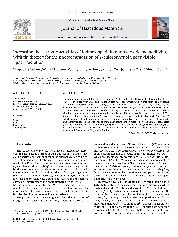摘要
The photocatalytic degradation of 2-chlorophenol (2-CP) irradiated with visible light over iodine doped TiO2 (IT) modified with SnO2 (SIT) nanoparticles has been investigated in this study. The structure and optical properties of the SIT catalysts have been well characterized by X-ray diffraction, the Brunauer-Emmett-Teller method, transmission electron microscopy, UV-visible absorption spectra and X-ray photoelectron spectroscopy. The effects of preparation conditions, such as SnO2 content and calcination temperature, on the photocatalytic degradation efficiency have been surveyed in detail. The improved photocatalytic activity of SIT is derived from the synergistic effect between the SnO2 and IT, which promoted the efficiency of migration of the photogenerated carriers at the interface of the catalysts and thereby enhanced the efficiency of photon harvesting in the visible region. The action of scavengers (fluoride ion, iodide ion, tert-butyl alcohol, and persulfate ion), as well as N-2 purging on the photodegradation rate reveal that the valence band hole is mainly responsible for the effective photocatalytic removal of 2-CP and the corresponding TOC reduction.
